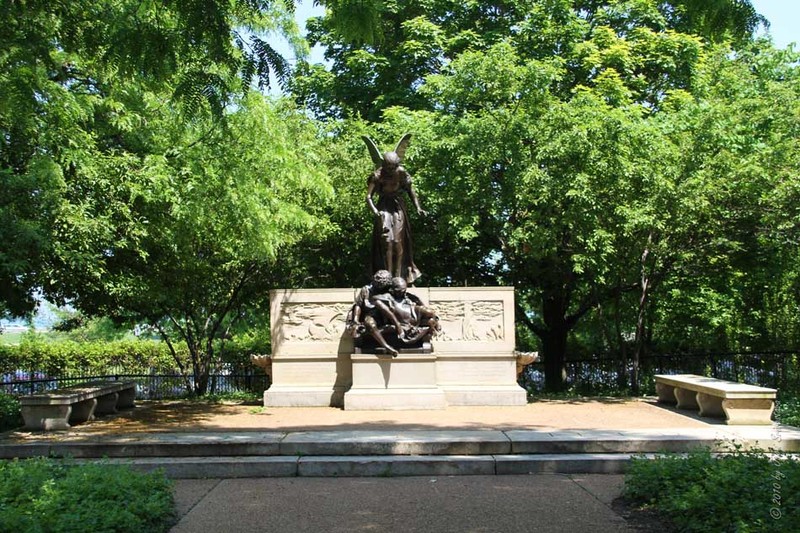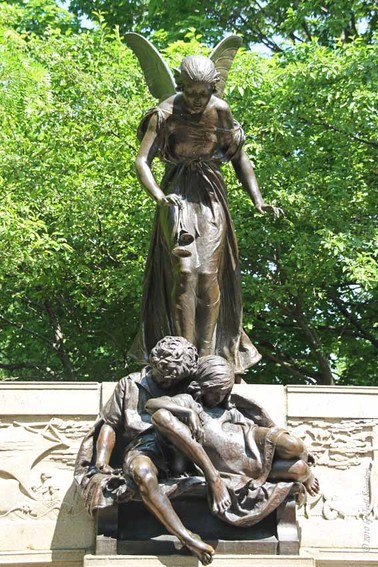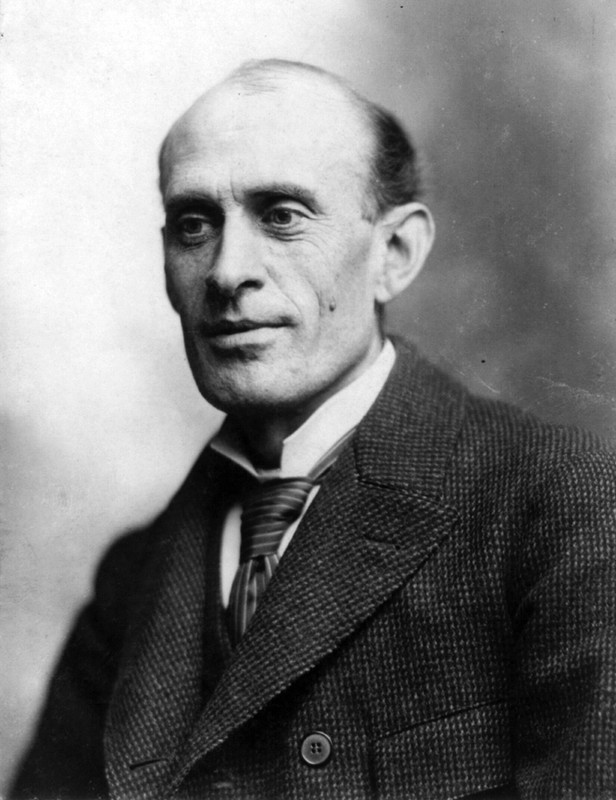Dream Lady: The Eugene Field Memorial
Introduction
Text-to-speech Audio
Images
Dream Lady: The Eugene Field Memorial

A closer look at the bronze sculptures

Eugene Field (1850-1895)

Backstory and Context
Text-to-speech Audio
Eugene Field was born on September 2, 1850 in St. Louis, Missouri. His father, Roswell Field, was an attorney who gained fame for representing enslaved African American Dred Scott before his case reached the U.S. Supreme Court. When Field was just six years old, his mother died. Unable to properly care for his children due to his busy legal career, Roswell Field sent young Eugene to live with a relative in Amherst, Massachusetts. A poor student, Field barely graduated from high school and only secured admission to Williams College in Massachusetts due to family connections. After several months at Williams, he dropped out to return to St. Louis to care for his ailing father. After his father’s death, Field enrolled at Knox College in Galesburg, Illinois, but was expelled after a practical joke went awry. He then returned to his native state and enrolled at the University of Missouri at Columbia. Field, however, failed his required math courses and never graduated. In 1871, he collected his substantial inheritance and traveled across Europe with a close friend, Edgar Comstock. In only six months, he spent his entire inheritance.
Out of money and in need of work, Field returned to Missouri and took a job writing for the St. Louis Evening Journal. He prospered in the position and was promoted to editor after only six months. With his employment situation stabilized, Field married Julia Comstock, the younger sister of his close friend, in 1873. The marriage proved a happy one and produced eight children, five of whom survived to adulthood. His children, whom he loved deeply and unconditionally, provided the inspiration for much of his later poetry. Three years after marrying, Field joined the St. Louis Times-Journal. During his time with the newspaper, he wrote a regular column entitled “Funny Fancies.” Containing humorous article, short stories, and poetry, it became popular and was reprinted in other newspapers.
In 1881, Field became managing editor of the Denver Tribune. During his two years with the newspaper, his most popular columns were “The Current Gossip” and “Odds and Ends,” both of which satirized daily life in early Denver. While living and working in the city, Field also published his first book, The Tribune Primer (1881), for which most of the material came from his columns. The same was true for another one of his works, a collection of poems entitled A Little Book of Western Verse, published in 1889.
Two years after arriving in Denver, Field accepted a position at the Chicago Morning News (renamed the Record in 1890). During his time in the Windy City, he reached the peak of his productivity and garnered national fame. Field published several books and hundreds of poems. Most of his poetry focused on children and childhood. “Little Boy Blue” (1888) and “Wynken, Blynken, and Nod” (1889) not only brought him national renown, but also earned him the moniker, the “Poet of Childhood.” Additionally, while at the Morning News, he continued to write “The Current Gossip,” but changed the name to “Sharps and Flats.” It eventually became the most popular column of its time. Thousands of newspapers across the country reprinted it daily. Capitalizing on his newfound fame, Field traveled both the United States and Europe delivering speeches and reading his poetry to gatherings of adoring fans and eager listeners. On the evening of November 4, 1895, the day before he was set to travel to Kansas City to attend one of these engagements, Field died suddenly and unexpectedly in Chicago. He was forty-five years old.
Following Field’s death, a number of Chicago newspaper editors began an effort to raise funds for the erection of a memorial to commemorate the late journalist and poet. The fundraising campaign proved arduous and lasted more than two decades. Thanks to nominal donations from children across the country and a major gift from the B.F. Ferguson Fund of the Art Institute of Chicago, the group was able to commission sculptor Edward Francis McCarten and the architectural firm of Delano & Aldrich to design the memorial. Dedicated in Lincoln Park in 1922, the memorial, entitled Dream Lady, consists of two bronze sculptures on a rectangular granite base. One of the sculptures, a female fairy-like figure, hovers over another of two peacefully sleeping children. Carved into the granite base are scenes and verses from some of Field’s poems. At each end of the rectangular base is a child-sized drinking fountain. The memorial originally stood at the northwest corner of what is now the Lincoln Park Zoo’s Helen Brach Primate House. It was eventually moved to its current location northeast of the exhibit.
Sources
"Eugene Field." Denver Public Library. Web. 23 February 2021 <https://history.denverlibrary.org/colorado-biographies/eugene-field-1850-1895>.
"Eugene Field." Encyclopædia Britannica. Web. 23 February 2021 <https://www.britannica.com/biography/Eugene-Field>.
"Eugene Field." Poetry Foundation. Web. 23 February 2021 <https://www.poetryfoundation.org/poets/eugene-field>.
"Eugene Field Memorial." Chicago Park District. City of Chicago. Web. 23 February 2021 <https://www.chicagoparkdistrict.com/parks-facilities/lincoln-park-eugene-field-memorial>.
http://chicago-outdoor-sculptures.blogspot.com/2009/07/dream-lady-eugene-field-memorail.html
http://chicago-outdoor-sculptures.blogspot.com/2009/07/dream-lady-eugene-field-memorail.html
https://en.wikipedia.org/wiki/Eugene_Field
